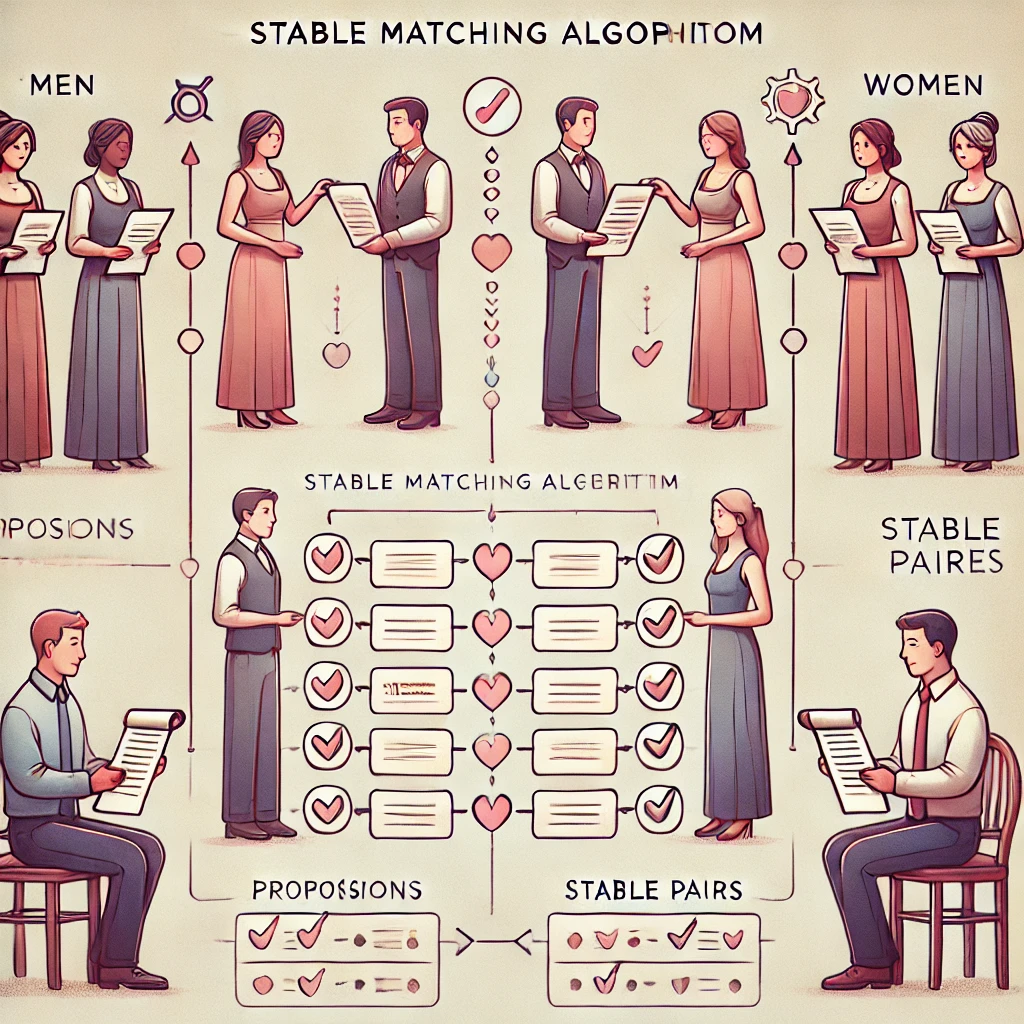The Stable Matching Problem: Finding Love, the Algorithmic Way!
 Harshwardhan Singh
Harshwardhan Singh
Imagine a world where every person has their perfect match, but finding that match isn't as simple as just meeting someone. What if I told you there's an algorithm to make it work, where no one ends up heartbroken, and everyone is happy? That's exactly what the Stable Matching Problem solves!

Whether it’s pairing college applicants with universities, or people with jobs, or even—wait for it—couples in love, this problem tackles how to form perfect, stable pairs. Stick with me to the end, and you'll understand how to crack this "stable" code!
Love at First Algorithm?
Okay, picture this: You have a group of men and women (for simplicity’s sake, let’s assume equal numbers). Each person has their own preference list, ranking who they would prefer to be with.
Now the goal is to find a perfect matching where no one cheats on their partner or thinks, “Ugh, I could’ve done better.”
Sounds tough? It's actually quite manageable thanks to an algorithm designed in 1962 by David Gale and Lloyd Shapley (a matchmaker's dream!). The solution always results in what's called a stable matching.
What’s Stable Matching?
Before diving into how this magical algorithm works, let’s define stability. A matching is called stable when there’s no couple where both the man and the woman would prefer each other over their current partners.
If Jack prefers Jill over his current match, and Jill also prefers Jack, they’re going to ditch their partners and be together. This creates instability.
But a stable match prevents that. Everyone sticks with their partner because there’s no one better (in their eyes) who also feels the same way.
Sounds like the rules of the dating game, right?

The Algorithm: Playing Cupid
Here’s how the Gale-Shapley Algorithm (also called the Deferred Acceptance Algorithm) works. Let’s walk through it with a fun scenario:
Step 1: The Setup
You have three men and three women, each with their own preferences.
Men’s Preferences:
John: ranks Alice first, then Bella, then Claire
Mark: ranks Bella first, then Alice, then Claire
Paul: ranks Claire first, then Alice, then Bella
Women’s Preferences:
Alice: ranks Mark first, then John, then Paul
Bella: ranks John first, then Paul, then Mark
Claire: ranks Paul first, then John, then Mark
Let’s run the algorithm and see how everyone pairs up.
Step 2: The Proposals
John goes to his first choice, Alice, and says, “Hey, I like you!”
- Alice is flattered but holds off on accepting since Mark (her #1 choice) might still propose. John is left hanging (ouch, tough luck).
Mark then proposes to Bella, his first choice.
- Bella accepts for now because he’s the first to ask her out.
Paul proposes to Claire, who happily accepts since he's her top choice.
Step 3: The Drama
Now, John tries his next option, Bella. But hold on—Bella is already with Mark! Does she dump him for John? Nope, she prefers Mark, so she rejects John (poor John!).
Mark, being smart, stays put with Bella.
John goes to his last option, Claire, but she's already happy with Paul and says, “No thanks.” John’s having a rough day.
Step 4: Happy Endings
Alice, who’s still waiting for her top pick Mark, realizes he’s not coming (since he’s happy with Bella). So, she accepts John’s original proposal!
Finally, we’re left with the pairings: John and Alice, Mark and Bella, and Paul and Claire.
But Is It Stable?
Yes! Let’s check:
John can’t do better because Bella rejected him, and Alice doesn’t prefer anyone over John.
Mark is happy with Bella, and she prefers him to everyone else.
Paul is paired with his top choice, Claire, and they’re perfectly content.
No one wants to swap partners—this is a stable matching! 🎉
Why It Works Every Time
The Gale-Shapley algorithm always guarantees a stable match, no matter the preferences. The secret sauce? It lets one side propose while the other side gets to reject or accept. The deferred acceptance ensures that no one jumps too soon into a relationship and regrets it later.
Applications: It’s Not Just About Romance!
You might be thinking, “Okay, this is fun, but how does this relate to the real world?”
Great question! This algorithm is used in many real-life scenarios:
College Admissions: Universities and students rank each other, and the stable matching ensures no student gets a better offer after committing.
Job Assignments: Companies and applicants rank each other to find the best fit.
Organ Transplants: Even organ donors and recipients can be matched based on preferences!
A Quick Recap
Stable Matching is all about creating pairs where no one has any incentive to switch partners.
The Gale-Shapley Algorithm works by having one group propose while the other accepts or rejects, leading to stability.
It's used for everything from matchmaking to job placements to organ donations!
So, next time you think finding the perfect partner is hard, remember that there’s an algorithm that can do it for you. Who knew love could be so... algorithmic?
Ready to Solve One?
Try writing down a few preferences and simulate the algorithm yourself! Whether it’s with friends, jobs, or even matching socks, you’ll see how stable matching brings order to the chaos.
Subscribe to my newsletter
Read articles from Harshwardhan Singh directly inside your inbox. Subscribe to the newsletter, and don't miss out.
Written by

Harshwardhan Singh
Harshwardhan Singh
Hey there! I'm Harsh, Software Developer who loves to explore technology and writes about my learnings in the tech domain. Want to hear more from me? You can follow me on my Twitter: https://twitter.com/harshwsingh.